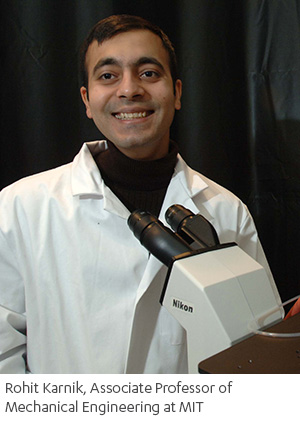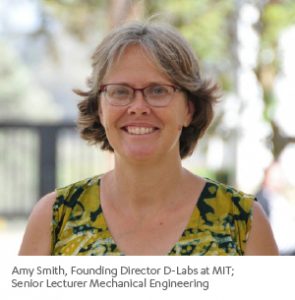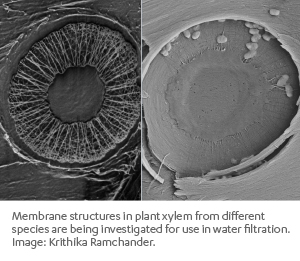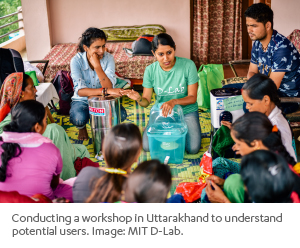J-WAFS in action: providing safe drinking water through wood

Rohit Karnik, Associate Professor of Mechanical Engineering at MIT, and Amy Smith, Senior Lecturer at MIT’s Department of Mechanical Engineering and founding director of D-Labs at MIT, are leading a group of researchers hoping to harness the natural qualities of xylem wood to provide safe, affordable drinking water to low-income groups. Opening Doors spoke to Rohit Karnik, Amy Smith, and team members Kendra Leith, Megha Hegde, and Anish Antony, about the project and its aims.
| What is the main issue you’re trying to address with this project?
Rohit: Many people across the globe still have to consume water that is unsafe for drinking. This leads to the spread of waterborne illnesses, with children under the age of five and the elderly being particularly at risk. In developed countries, the water supply is generally safe. In many cities in developing countries, too, most middle-income people have access to centrally treated water and can afford home-based water treatment methods, so the level of waterborne illness is not particularly high. But when you go to rural or low-income areas in developing countries, the water is often unsafe to drink. This is due to a range of factors, including lack of awareness, access to water treatment technologies, affordability, and issues around social acceptability. As a result, unsafe water causes many avoidable deaths each year. |
 |
In developed countries, the water supply is generally safe. In many cities in developing countries, too, most middle-income people have access to centrally treated water and can afford home-based water treatment methods, so the level of waterborne illness is not particularly high. But when you go to rural or low-income areas in developing countries, the water is often unsafe to drink. This is due to a range of factors, including lack of awareness, access to water treatment technologies, affordability, and issues around social acceptability. As a result, unsafe water causes many avoidable deaths each year.
Our research seeks to make use of a natural water-filtration technology that is quite different from those already on the market, with the hope of improving the supply of safe water to rural and low-income communities.
Our J-WAFS-sponsored project has enabled collaboration between the Karnik group and D-Lab. It builds off on prior work funded by the James Ferry Jr. fund and the Tata Center for Technology and Design at MIT, which continues its support for the project. We are also grateful to Himmotthan Society, People’s Science Institute, Pan Himalayan Grassroots Foundation, the Tata Trusts, MIT facilities, and many others who have supported this work.
| How do low-income groups currently access safe and affordable drinking water?
Amy: Lots of people, particularly in the areas of India that we’re exploring, aren’t treating water at all. And much of that comes down to a lack of awareness. People think their water is clean because it’s coming from springs in the mountains, but water tests and interviews with key informants indicate the water is contaminated. Even where people do treat their water, treatment can be unreliable. Sometimes water can get re-contaminated if it is not stored properly, or filters may not be changed as often as necessary to be fully effective. The result is that people suffer unnecessarily every year from waterborne diseases. |
 |
What is your proposed solution, and how does it work?
Rohit: When plants draw up water through their roots and take it into the leaf through their xylem tissue, it can cause bubbles in the water. To get rid of these bubbles, the plants have membranes in the xylem that filter them out.
 |
In previous research, we showed that these same xylem membrane structures can also be used to filter water and remove bacteria. Now, we’re trying to understand the technology further and develop it to a stage where we can use the same idea to design practical, usable water filters based on xylem.
One advantage of using xylem is that it’s made from sapwood, which is low-grade wood. It is not as expensive as heartwood and, in a sense, is a byproduct of the timber trade. So rather than needing to manufacture some kind of artificial membrane or filtration cartridge, we have this ready-made source of filtration. |
We just need to apply a simple treatment to turn it into a filter element that only costs a few cents.
How much would each filter cost?
Rohit: A xylem filter would consist of a filter device housing a xylem filter element. As xylem is organic, it degrades with time, so the filter element would need to be replaced every week, for example, at which point it can be used for fuel. Although many different filter device designs are possible, our field studies suggest that users would prefer an upfront device cost of US$ 10-15 and a weekly replacement cost of less than US$ 0.40. In comparison, most water filters available today cost US$ 15-25 and have cartridges costing US$ 5-10 that need to be replaced every few months. Even with weekly replacement, we expect the xylem filter to be cost-effective since the filter element is only a few cents. People in the lowest income brackets would rather pay a few cents each week than a larger sum every few months. In addition, because xylem is a natural material, it is a more socially acceptable process than, for example, adding a chemical to water.
Where are xylem filters most suitable?
Rohit: The filters will be most impactful in areas where the burden of waterborne diseases on health is high and access and affordability to water treatment methods is an issue. The scale of the technology makes it more suitable for use at a household level rather than the community level. The product would have a low recurring cost, and that would empower people to pay for it when they need it – for example, in monsoons, when the water gets more dangerous to drink and contamination levels are higher. We could also design different products tailored to different needs, with different flow rates and capacities, or even something the size of a wallet that can be easily air-dropped in emergencies.
What could this mean for areas living under severe water stress, such as the Middle East and North Africa?
Rohit: Water filtration technologies address the quality of water in a given area. Availability and quality go hand-in-hand in a sense because if you have contaminated water, it’s not very useful. The xylem filtration technology will not change the total amount of water in an area, but it could change the amount that could be safely consumed.
What are your biggest challenges at this stage, and how will you address them?
| Rohit: First, we’ve got to fully understand the technology and develop it to a stage where we can design practical, usable water filters. We’ve also got to spend time really trying to understand what would make this a useful technology. What are the preferences of the people who are going to be using it? It’s an exploratory project in a sense because there are multiple solutions available for treating water – each with its own pros and cons – whereas we’ve stumbled upon something that has the potential to be quite different from anything else out there. |  |
Will this funding period be enough to bring your research to completion?
Rohit: During this funding period, we’re hoping to get the technology to a stage where it can take off. By that, we mean having a good understanding of users and behavioral change, as well as advancing the technology to a prototype that is functional, reliable, and usable.
If we reach those milestones and have a clear roadmap for manufacture and further development, the next stage will be to take the technology to market.
How soon could we see your product brought to market?
Rohit: We’re exploring this as an open-source technology, where we’d provide some basic knowledge and a foundation as to how to reliably make xylem filters and its possible designs. Different end-users and developers could then take it forward to suit their own needs.
In terms of the time to market, that’s always like gazing into a crystal ball. It could be as soon as two years, but in reality, you never know what’s going to happen.
We need to get the right teams in place, get the right entrepreneurs and business partners on board, and deal with lots of regulatory issues. We’re hoping this part of the project will set the stage for all those things to happen and gain the interest of a wide range of people to take this forward.



 Added to press kit
Added to press kit


